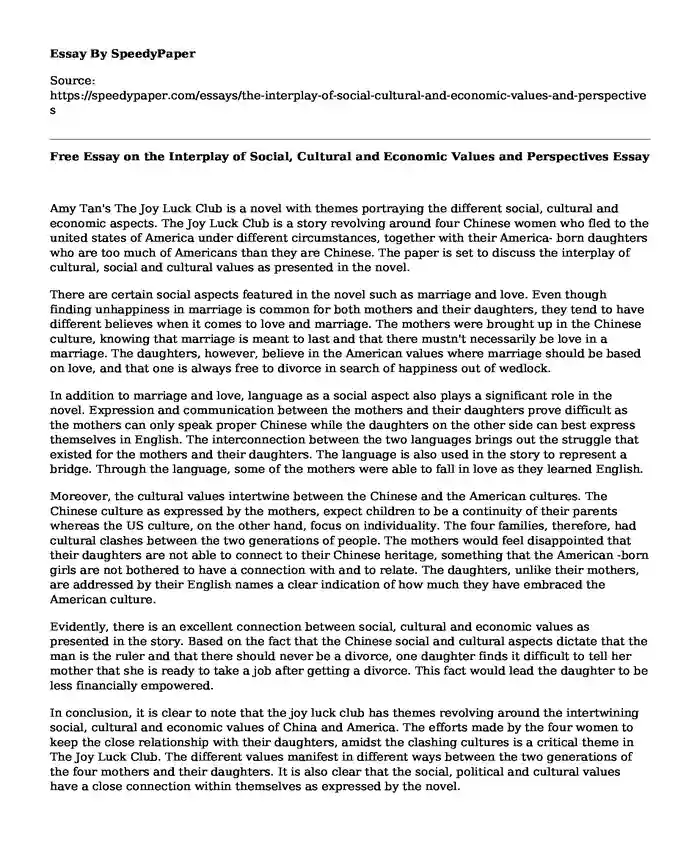Amy Tan's The Joy Luck Club is a novel with themes portraying the different social, cultural and economic aspects. The Joy Luck Club is a story revolving around four Chinese women who fled to the united states of America under different circumstances, together with their America- born daughters who are too much of Americans than they are Chinese. The paper is set to discuss the interplay of cultural, social and cultural values as presented in the novel.
There are certain social aspects featured in the novel such as marriage and love. Even though finding unhappiness in marriage is common for both mothers and their daughters, they tend to have different believes when it comes to love and marriage. The mothers were brought up in the Chinese culture, knowing that marriage is meant to last and that there mustn't necessarily be love in a marriage. The daughters, however, believe in the American values where marriage should be based on love, and that one is always free to divorce in search of happiness out of wedlock.
In addition to marriage and love, language as a social aspect also plays a significant role in the novel. Expression and communication between the mothers and their daughters prove difficult as the mothers can only speak proper Chinese while the daughters on the other side can best express themselves in English. The interconnection between the two languages brings out the struggle that existed for the mothers and their daughters. The language is also used in the story to represent a bridge. Through the language, some of the mothers were able to fall in love as they learned English.
Moreover, the cultural values intertwine between the Chinese and the American cultures. The Chinese culture as expressed by the mothers, expect children to be a continuity of their parents whereas the US culture, on the other hand, focus on individuality. The four families, therefore, had cultural clashes between the two generations of people. The mothers would feel disappointed that their daughters are not able to connect to their Chinese heritage, something that the American -born girls are not bothered to have a connection with and to relate. The daughters, unlike their mothers, are addressed by their English names a clear indication of how much they have embraced the American culture.
Evidently, there is an excellent connection between social, cultural and economic values as presented in the story. Based on the fact that the Chinese social and cultural aspects dictate that the man is the ruler and that there should never be a divorce, one daughter finds it difficult to tell her mother that she is ready to take a job after getting a divorce. This fact would lead the daughter to be less financially empowered.
In conclusion, it is clear to note that the joy luck club has themes revolving around the intertwining social, cultural and economic values of China and America. The efforts made by the four women to keep the close relationship with their daughters, amidst the clashing cultures is a critical theme in The Joy Luck Club. The different values manifest in different ways between the two generations of the four mothers and their daughters. It is also clear that the social, political and cultural values have a close connection within themselves as expressed by the novel.
Work Cited
Tan, Amy. The Joy Luck Club. Penguin Books, 2016.
Cite this page
Free Essay on the Interplay of Social, Cultural and Economic Values and Perspectives. (2022, Feb 21). Retrieved from https://speedypaper.net/essays/the-interplay-of-social-cultural-and-economic-values-and-perspectives
Request Removal
If you are the original author of this essay and no longer wish to have it published on the SpeedyPaper website, please click below to request its removal:
- Future of Nursing in This Free Essay
- Introduction of Opinions and Expert Testimony at Trial - Free Essay in Crimial Law
- Biology Essay Example: Frog Evolution
- Free Essay on Police Response to Domestic Violence
- American Dream Essay Example
- Free Essay on How Emotional Labor Influences the Hospitality Industry
- Essay Example on Technology: Nest Smart Learning Thermostat
Popular categories





